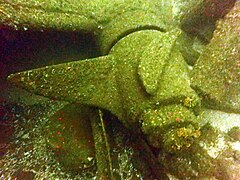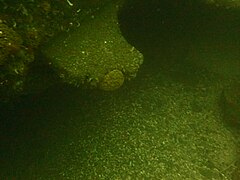The dive site Robben Island steamer wreck is a recent offshore wreck about 0.8 nautical miles off the south-western side of Robben Island in the approaches to Table Bay, near Cape Town in the Western Cape Province of South Africa.
Understand
[edit]
The wreck is not marked on the navigational charts, and there is no known record of a wreck at this position, but there are many wrecks in Table Bay for which the position is not accurately recorded.
Position
[edit]- 1 Robben Island steamer: S33°49.886, E018°21.524 — Approximate centre of wreck
- S33°49.882, E018°21.550 (Bow)
- S33°49.887, E018°21.519 (Stern)
This site is in a Restricted Area in the Robben Island Marine Protected Area since 2019. A permit is required.
Depth
[edit]Maximum depth is about 38 m on the adjacent sand, and the top of the bow is at about 28 m. (Average depth of a dive is likely to be about 34 m.)
Visibility
[edit]Visibility is likely to be similar to other parts of Table Bay, and is likely to be best after prolonged or strong South Easterly wind, which is more likely in summer. Visibility at depth may vary significantly from near the surface.
Topography
[edit]Wreck of an unidentified steel steamer, spotted on a geological survey. The wreck is approximately 48 m long, 9 m beam, lying roughly east-west true, with the bow to the east. The hull lies on a flat sand bottom, canted about 30° to port. The ship has a slightly flared plate bow, with very little bow overhang, and square hawse openings. No anchors have been seen yet. There is a winch on the forecastle deck, and a small amount of railing at the bow, The forecastle seems a moderate size and has no bulwarks. The vessel has a cruiser stern, with a fairly long raised quarterdeck, terminating just aft of the boiler. The hull plating appears smooth, and without visible riveting or laps at the joints. There is a single riveted scotch boiler, about 4 m long, maybe 3 m diameter, fairly intact, but the stack ducting is completely gone, with fire tubes exposed forward. number of fireboxes has not been reported. There are some heavy accessories on top of the boiler, possibly including the safety valve. There are no reports on the engine, but it may be inside the remaining hull structure aft of the boiler. The deck plating is severely wasted on the quarterdeck, but in better condition on the forecastle. A "Shires" ceramic toilet bowl is reported from the forecastle of a model typical of the 1950s to 1960s. Some plating lies on the bottom on both sides of the hull, which could be collapsed hull side plating. The rudder is gone, but the point where the stock would exit the hull is visible. The ship had a single propeller, probably four bladed, possibly cast iron, with broken blades, in a conventional vertical sternpost.
Geology: Sand bottom in a gap between areas of reef, probably pre-Cambrian sedimentary rock of the Tygerberg formation.
Conditions
[edit]The site is exposed to westerly swells so should be dived in fairly low swells, and may be good after a strong south easterly wind, but is very exposed to wind from all directions. If a strong south-easterly wind develops while diving it would be prudent to leave early as the trip back to Cape Town will be uncomfortable. The site should be at it's best in late summer but there are also occasional opportunities in other seasons.
This is an area which sometimes has upwellings of cold clear water, caused by strong south easterly winds, resulting in good but cold diving conditions, usually followed by a plankton bloom after a day of sunshine. The site is fairly deep and visibility at depth may be much better than at the surface after a plankton bloom.
Get in
[edit]Access is by boat, either from the V&A Waterfront, or from Granger Bay.
The site is about 9.2 km from the Oceana Power Boat Club slipway at Granger Bay, or about 12 km from the V&A Waterfront.
There are day charter boats which can take a diver to any of the dive sites in the region, but most operators only work from a limited number of launch sites, which limits the dive sites they visit. Visits to a dive site also depend on the weather and are generally not predictable or bookable more than two to four days in advance. See the listing for Cape Peninsula and False Bay boat dive charters and the associated services directory for contact details.
See
[edit]Marine life
[edit]Light encrustation of sponges and soft corals.
- Sunburst soft coral Malacacanthus capensis on the wreck at 30 m depth
- Starfish and sponge on the hull plating
Features
[edit]The low level of marine growth leaves the wreck relatively accessible for investigating the wreckage. No penetrations have been reported yet, but there is a fair amount of the forecastle and stern which may be accessible.
- Hub of the propeller of the unidentified shipwreck off Robben Island
- Detail of the hull of where the rudder was fitted
Photography
[edit]
The wreck is not very heavily encrusted with marine organisms, so not much of a destination for macro-photography. The visibility will determine whether scenic photos of the wreckage are an option. A wide angle or fish-eye lens is likely to be a good choice most days. The site is fairly deep and likely to be quite dark. Artificial lighting may be necessary even for monochrome.
Suggested routes
[edit]The wreck is fairly small, but the available bottom time is not long, so stay on the main part of the wreck.
Stay safe
[edit]Hazards
[edit]The interior of the wreck has not been dived, but based on the size of the vessel it is likely to be tight, and may be silty. Follow wreck penetration procedures if you enter. The wreck is deep enough that nitrogen narcosis may affect most divers using air or nitrox.
Skills
[edit]Deep diving skills are recommended, and the ability to deploy a DSMB in case you don't get back to the shotline. Ascents without a marker could get you lost if there is much wind and a current.
Equipment
[edit]Nitrox is recommended for a reasonable bottom time, and a DSMB in case of ascent away from the shotline in wind or current.
Nearby
[edit]- 1 MV Treasure
- 2 MV Afrikaner
- 3 SS Hypatia
- 4 Whale Rock
- 5 MV Daeyang Family
- 6 MV Winton
- 7 MV Gemsbok
- 8 Highfields
- 9 SS Cape Matapan
- 10 SS SA Seafarer
- 11 RMS Athens
- 12 Two Oceans Aquarium
- 13 Three Anchor Bay
- 14 Sea Point Ridge Pinnacles
Back to the Alphabetical list of sites, or list of dive sites in the Robben Island area
Other regional dive sites:
- Dive sites of the Cape Peninsula west coast
- Dive sites of the Cape Peninsula east coast
- Dive sites of False Bay offshore and approaches
- Dive sites of False Bay east coast
- Fresh water dive sites of the Cape Town Metropolitan Area






